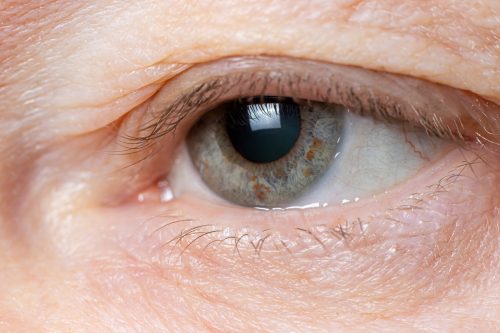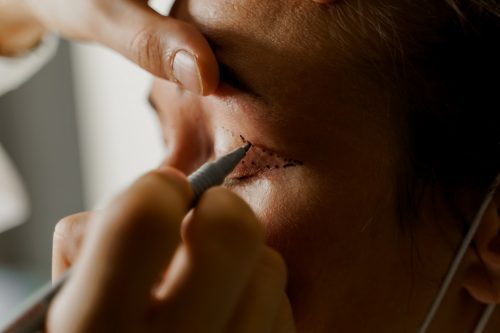Droopy eyelids can be more than a cosmetic problem – they can also affect a person’s vision. Focus spoke with ophthalmic plastic surgeon Grace Lee, MD, about the different causes of droopy eyelids and the surgical and non-surgical treatment options available.
What causes droopy eyelids?

Droopy eyelids can be split into two categories. One is called “dermatochalasis,” which means there is excess skin draping over the upper eyelid fold and causing weight or heaviness on the eyelids and eyelashes. Generally, dermatochalasis is age-related—as skin loses elasticity over time, it can become stretched and droopy and may even affect a patient’s peripheral vision.
The other is “ptosis,” which happens when the upper eyelid muscle doesn’t work properly and causes the eyelid itself to droop over the eye. Most cases of ptosis are related to aging. As we age, the muscle holding up the eyelid becomes stretched or detached from its base and is no longer as effective in elevating the eyelid. There are other less common, but potentially more serious, causes of eyelid ptosis, including potential nerve palsies or muscular disorders. Ptosis can also be associated with previous eye surgeries or caused by chronic eye drop use or contact lens wear. Therefore, it’s important to be evaluated by an ophthalmologist to determine the root problem.
When do droopy eyelids start to appear?
Droopy eyelids can occur at any age. Dermatochalasis and most cases of ptosis occur in people over 40 years old. However, ptosis can occur earlier, depending on the cause.
Is there a difference between ptosis in children and adults?
When a patient has ptosis at a very young age—particularly at birth—it’s called congenital ptosis. This is generally due to a developmental abnormality in the eyelid muscle structure that causes the muscle to be weak and unable to fully lift the eyelid. In rare cases, congenital ptosis can be caused by neurologic disorders. Determining whether a patient has congenital or adult-acquired ptosis is important when figuring out how to fix the problem.
Can a droopy eyelid affect vision?
Ptosis or dermatochalasis can cause both cosmetic and functional issues. When a patient comes for an evaluation in our clinic, we generally ask if he or she is experiencing any difficulties with vision or performing normal daily activities, like reading or driving. Sometimes the drooping can be so severe that it can cause a blockage in the peripheral vision. When this occurs, the patient must lift his or her eyelid manually or excessively use the forehead muscle to raise the eyelids. These cases are considered functional, and with the appropriate testing, the patient can undergo surgery that is covered by health insurance.
How is droopy eyelid typically treated?
 Surgical correction of dermatochalasis or ptosis is the most permanent solution. Generally, this can be done as an outpatient surgery—either under local anesthesia or with conscious sedation.
Surgical correction of dermatochalasis or ptosis is the most permanent solution. Generally, this can be done as an outpatient surgery—either under local anesthesia or with conscious sedation.
For patients with dermatochalasis, we do a procedure called blepharoplasty, where an incision is made in the eyelid crease and the excess skin is removed.
Surgically correcting ptosis is slightly more complicated because it involves muscles deeper in the eyelid. Depending on the patient, there are two options. One, go underneath the eyelid to remove part of the Muller’s muscle, which maintains the elevation of the upper eyelid. And two, make an incision through the skin of the eyelid to tighten and adjust the levator muscle, which also contracts to lift the eyelid.
Patients are typically very swollen the day post-surgery, so we recommend frequent use of ice compresses after the procedure. The swelling generally goes down dramatically about one week after surgery.
Are there non-surgical treatment options?
Some of my patients have felt a temporary improvement using eyelid tape or eyelid glue to hold up excess skin, but this may not be appropriate for everyone, as allergic reactions or skin irritation can occur. And it’s not a permanent solution.
There is also a new drug that’s been approved by the U.S. Food and Drug Administration, called Upneeq, that can relieve minor symptoms of ptosis. Formulated as a daily eye drop, it activates one of the muscles that elevates the eyelid. I generally reserve this option for patients who have minimal ptosis who don’t want to undergo cosmetic ptosis repair. This may also be an alternative for patients where eyelid surgery would be unsafe. For instance, if a patient was unable to stop taking blood thinner ahead of the surgery or is too sick or unstable to undergo surgery.
Is surgery covered by insurance?
Every insurance plan is different, but in general, insurance companies provide partial or full coverage if the condition is shown to impact the patient’s ability to see. Before scheduling the procedure, a doctor may take photographs of the eye and perform a visual field test. Upneeq is not currently covered by insurance.
What should someone do if they’re concerned about droopy eyelids?
The first step is to be evaluated by an ophthalmologist. Once the root cause is determined, the eye doctor may refer the patient to an ophthalmic plastic surgeon for an evaluation.
Request an appointment at the Mass Eye and Ear Ophthalmic Plastic Surgery Service.
About Our Expert
Grace Lee, MD , is an ophthalmic plastic surgeon and a member of the Mass Eye and Ear Ophthalmic Plastic Surgery Service and the Center for Thyroid Eye Disease and Orbital Surgery. Her areas of expertise include orbit, eyelid, and tear drainage system dysfunctions; orbital tumors and inflammations; traumatic lacerations and fractures; and reconstructive and cosmetic eyelid surgery.
, is an ophthalmic plastic surgeon and a member of the Mass Eye and Ear Ophthalmic Plastic Surgery Service and the Center for Thyroid Eye Disease and Orbital Surgery. Her areas of expertise include orbit, eyelid, and tear drainage system dysfunctions; orbital tumors and inflammations; traumatic lacerations and fractures; and reconstructive and cosmetic eyelid surgery.
I am looking for someone to look at under the eye drooping and a festoon and under my right eye
Hi Kathleen, thanks for reading. For a consultation with Dr. Lee’s office, please call 617-573-5550.
I would like to make an appointment with dr lee to see if I am a candidate for one of the surgeries above
Hi Karyne, thanks for reading and your comment. Dr. Lee’s office can be reached at 617-573-5550 for an appointment.
This article came at the right time. I have a droopy left eye and eye lid and would like a consultation. I do see Dr. Goldstein at Mass Eye and Ear on a yearly basis. Have not contacted him yet but I would think this is more your specialty. Thanks Vartus
Hi Vartus, thanks for reading, glad to hear you’re a long-time patient of Mass Eye and Ear! Dr. Lee’s office can be reached at 617-573-5550. Good luck!
I have dermatochalasis and have vision problems. I would like to set up an appointment with Dr. Lee.
Hi Marlene, thanks for your comment. Dr. Lee’s office can be reached at 617-573-5550.
was wondering if Dr. Lee performs endoscopic brow lift at the same time she does a bilateral upper lid blepharoplasty. I live in North Conway NH and wanted to know if she does this procedure at other surgical centers or just Mass General due to a very long drive. Thank you!
Hi Robin. Dr. Lee generally will operate with a facial plastic surgeon who does the endo brow if they feel it is warranted. They do both aspects of the surgery together as much as it is possible. But a patient would require two, separate consultations in that case if they truly want a brow lift. Occasionally they are able to accommodate by scheduling appointments on the same day. Hope that helps!
deseo concentar una cita para examinar los parpados si soy candidata para una sirugia
Gracias Matilde, para una cita con Dr. Lee, llama 617-573-5550.
Dr. Lee performed surgery on both my upper eyelids. The result is amazing, I highly recommend. Dr. Lee is personable and very professional. Procedure was brief and painless. I had no post-op issues. Wonderful result!
Thanks for your reading and your comment, Kevin. So glad to hear you had a great experience with Dr. Lee and Mass Eye and Ear!
Thank you so much, Dr. Lee.. I came to the News Letter looking for ways to contact Dr. John Kemptan who treated me for Uveitis and saved my eyesight in 2015 while practicing at U. Of PA Hospital in Phila. PA. Instead I read your article about droopy eyelids, which gave me an alternative to the (frightening) procedure that was offered. I am 84 yrs. old and too weak to travel long distances but I thank you so much for giving me peace of mind.
Gratefully,
Lillian D. McKethan